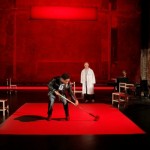NY Theater Review by Paulanne Simmons
When neurologist Oliver Sacks writes about patients who see the world very differently from the average person, his case studies are fascinating and sometimes frightening. When director Peter Brook writes about the same subject, the result is a play that is fascinating, frightening and sublimely dramatic.
Indeed The Valley of Astonishment, written and directed by Brook and Marie-Hélène Estienne, was inspired by neurological studies. But it is also hugely influenced by the poetry of the Persian Sufi, Farid Attar, particularly his poem, “The Conference of Birds.”
In “The Conference of Birds,” thirty birds go on a pilgrimage in search of their ideal king, the Simorgh bird. Led by the poet Attar, who has been transformed into a sharp-beaked, crested hoopoe, they go through seven valleys, a journey that might remind us of Dante’s Divine Comedy, John Bunyan’s The Pilgrim’s Progress, or the late 15th-century morality play Everyman. It is in the valley of astonishment that the birds experience both beauty and despair.
In The Valley of Astonishment, we are presented with the stories of several unique people, most of whom have some form of synesthesia. In medical terms, this is a neurological condition in which the stimulation of one of the five senses simultaneously stimulates another. In poetry, however, synesthesia is figurative language that describes one kind of sensation in terms of another. Although the play addresses synesthesia as a medical condition, the characters use the language of poetry to describe it.
Their stories are enacted by an ensemble cast of three actors, Kathryn Hunter, Marcello Magni and Jared McNeill; with two musicians, Toshi Tsuchitori and Raphael Chambouvet. One story focusses on a painter who hears music as colors. Another is about a man who can no longer feel his body and must teach himself how to move. But the central, most arresting story is that of a woman named Samy Costas (Hunter), based on the life of Solomon Shereshevsky, described in Alexander Luria’s book The Mind of a Mnemonist).
After Samy’s infallible memory is discovered by her boss and corroborated by medical research, she loses her job (she’s too talented for it, her boss says) and becomes a celebrity, astonishing audiences by repeating long lists of random words. In her first show, she is preceded by the magician, René Lavand, in a highly entertaining scene that requires audience participation. But fame does not bring happiness.
Hunter is a brilliant actress who can be ironic, funny and moving all at the same time. She makes Samy, who is so unlike most of us, seem both familiar and universal. Her despair and confusion are palpable.
The Valley of Astonishment makes creative use of a minimalist set. A few wooden chairs and a wooden table are placed about the stage. A large, square sheet of paper spread out on the floor dominates the stage. Much of the action is mimed.
It would have been easy to turn this play into a lesson on abstract ideas or a theoretical treatise on the way the brain makes connections. Happily this is not the case.
Although The Valley of Astonishment does take on concepts of eternity and infinity, illusion and reality, the material and the ideal, it also explores the very poignant question of how human beings make connections with each other and learn to live with themselves. It is at this intersection of the intellect and the emotions that great art and great theater arise.
The Valley of Astonishment, at Theatre for a New Audience, Polonsky Shakespeare Center, 262 Ashland Place, Brooklyn, through Oct. 5., 866-811-4111 or www.tfano.org.























